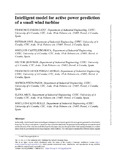Intelligent model for active power prediction of a small wind turbine

Use este enlace para citar
http://hdl.handle.net/2183/38292
Excepto si se señala otra cosa, la licencia del ítem se describe como Creative Commons Attribution License http://creativecommons.org/licenses/by/4.0/
Colecciones
- Investigación (EPEF) [590]
Metadatos
Mostrar el registro completo del ítemTítulo
Intelligent model for active power prediction of a small wind turbineAutor(es)
Fecha
2023-08Cita bibliográfica
Francisco Zayas-Gato, Esteban Jove, José-Luis Casteleiro-Roca, Héctor Quintián, Francisco Javier Pérez-Castelo, Andrés Piñón-Pazos, Elena Arce, José Luis Calvo-Rolle, Intelligent model for active power prediction of a small wind turbine, Logic Journal of the IGPL, Volume 31, Issue 4, August 2023, Pages 785–803, https://doi.org/10.1093/jigpal/jzac040
Resumen
[Abstract] In this study, a hybrid model based on intelligent techniques is developed to predict the active power generated in a bioclimatic house by a low power wind turbine. Contrary to other researches that predict the generated power taking into account the speed and the direction of the wind, the model developed in this paper only uses the speed of the wind, measured mainly in a weather station from the government meteorological agency (MeteoGalicia). The wind speed is measured at different heights, against the usual measurements in others researches, which uses the wind speed and the direction measured in a weather station on the wind turbine nacelle. The prediction is performed 30 minutes ahead, what ensures that the Building Management System knows the energy generated by the low power wind turbine 30 minutes before, and it can adapt the consumption of different equipment in the house to optimize the power use. The main objective is to allow the Building Management System to optimize the uses of energy, taking into account the predicted amount of energy that will be produced and the energy consumed in the house. The developed model uses a hybrid topology with four clusters to improve the prediction, achieving an error lower than 6.5% for Mean Absolute Error measured in a final test. To perform this test, part of the original dataset was isolated from the beginning of the training process to check the model with a dataset that is not used before, simulating the model as it is receiving new data.
Palabras clave
Intelligent model
Hybrid model
Low power wind turbine
Microgrid
Power prediction
Energy use optimization
Hybrid model
Low power wind turbine
Microgrid
Power prediction
Energy use optimization
Descripción
Funding for open access charge: University of A Coruña / CISUG.
Versión del editor
Derechos
Creative Commons Attribution License http://creativecommons.org/licenses/by/4.0/
ISSN
1368-9894






